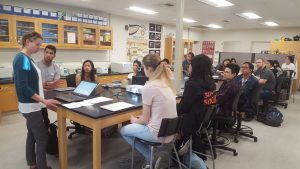The last class! We started class with students taking the same survey that they took on the first day of class. This took about 30 minutes. Then came time for students to analyze the Sanger sequences that they had prepared from the week before. Despite detailed instructions, students had a lot of questions in part …
We started class by talking about how to interpret our PCR results by looking at gel images. The goal for the day was to prepare the samples that worked (ie had positive bands on gel) for submission for Sanger Sequencing. We had a brief discussion about why we need to clean up PCR products, how …
There can be points when running a CURE where there are tradeoffs between student learning and the best utilization of class time. In this case, we set-up and ran the PCR for the students ‘behind the scenes’ rather than using class time for them to do it themselves. These ‘black boxes’ can be detrimental to …
The structure of these two weeks involving pH growth curves and analysis was very similar to that of the previous two weeks (osmolarity). Before class, our student assistants performed dilution streaks (instead of the students) and prepared overnight cultures from those plates. The overnight cultures were used by the students for the pH growth curves. …
Week 4: Osmolarity Growth Curves We started class by taking out the dilution streak plates that the students made in Week 3. We learned two things from this as instructors: (1) We did an amazing job teaching the technique for dilution streaking – all of the plates turned out beautiful! (2) We did not do …
Week 3: the science begins! There was an non-trivial amount of work required of the teaching staff to prepare for this class. What was that work? 1) Preparing fresh plates of microbial isolates – enough for one for each student, and demos. 2) Preparing fresh reagents for oxidase and catalase tests. 3) Growing a fresh …
One of the many reasons why I love being part of our UC Davis First Year Seminar CUREs is that we do not require our students to have previous scientific experience. What this also means is that we need to spend a lot of class time covering basic (yet very important!) laboratory skills. Therefore, Week …
CUREs, Course-based Undergraduate Research Experiences, represent a departure from traditional lecture-based teaching methods. In CUREs, students learn in a much more interactive environment. There is a growing body of literature suggesting CUREs benefit students – and therefore schools – far better than lecture-based teaching (Example 1, Example 2, Example 3). Members and collaborators of Jonathan …
“Social media is a waste of time”, “You should be writing grants”, “Spend more time at the bench and less time on Twitter” I don’t really want to wade into this discussion too strongly… there are a number of great resources out there documenting the utility of social media in science and science communication (examples …
I love the idea behind this: And see the associated story in AL.Com by Lee Roop Scientists study the microbiome – the bacteria, viruses and fungi – living in an Alabama high school. Basically this is a partnership between Hudson Alpha and a local school on doing the microbiome of their classroom. Though I would note …

